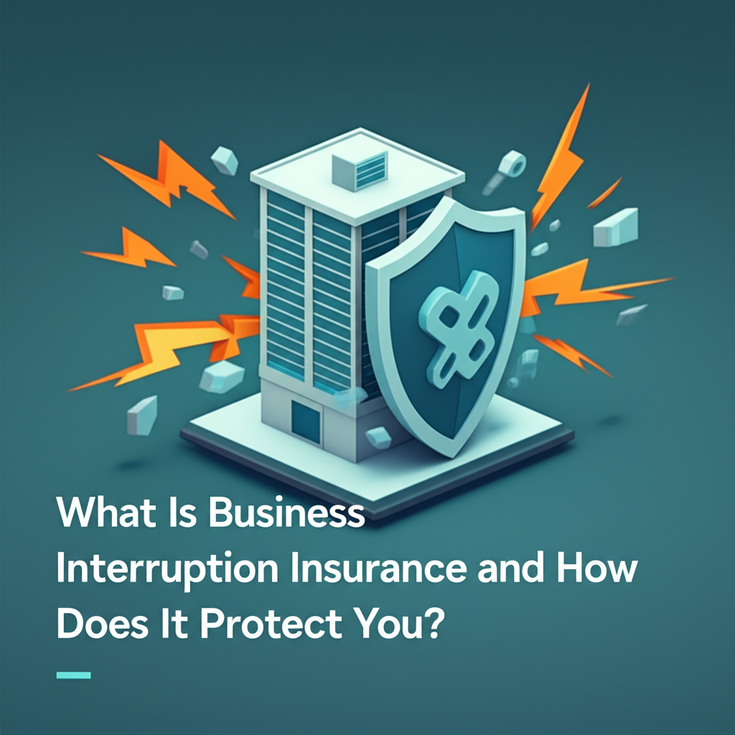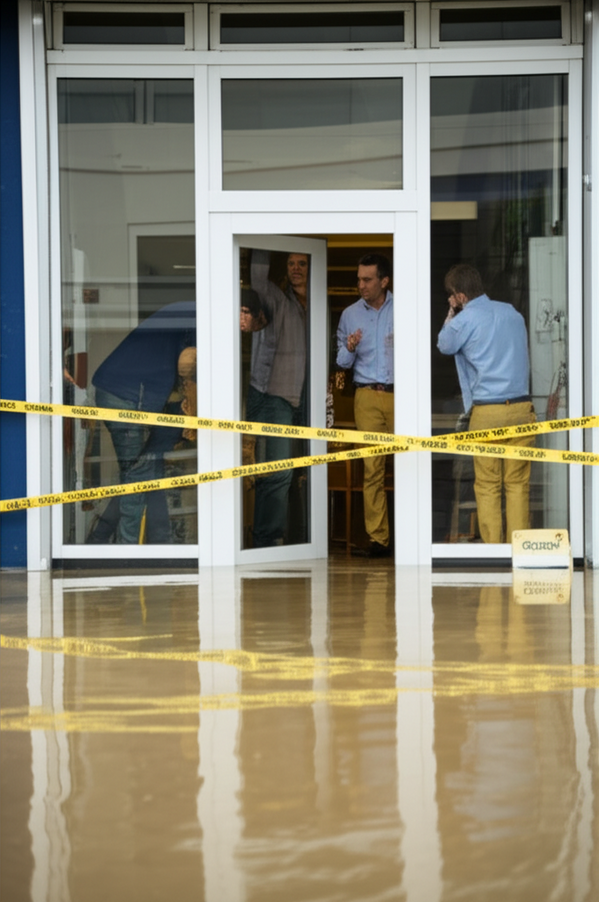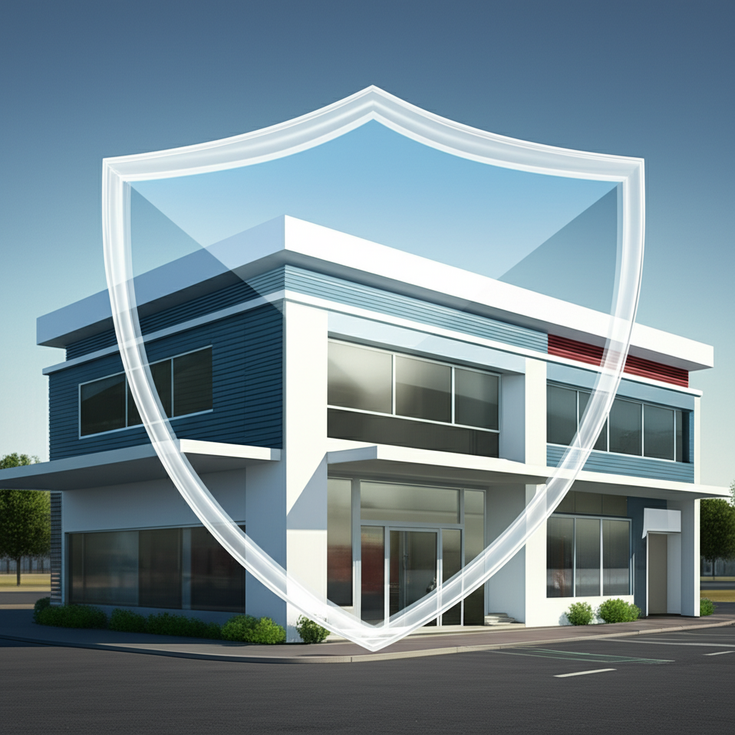What Is Business Interruption Insurance and How Does It Protect You?

Running a company means facing risks that can stop business. Many owners want to know: what is business interruption insurance? This coverage can help shield our company from losing money after a disaster closes our doors.
By reading, you will learn how business interruption coverage works, what it covers (and what it doesn’t), how claims work, and how much it costs. You will see simple tips and helpful real-world examples, so you can feel confident as you protect your business.
What will business interruption insurance do for your company?
Business interruption insurance acts as a financial backup plan. When disaster strikes and our company must close its doors, this insurance can cover ongoing expenses. It does so by focusing on the money our business loses during downtime. Owners who plan ahead can use this insurance to bounce back much faster.
A big benefit is replacing lost revenue. We don’t just lose property. We also lose the money we would have made. Some companies with smart coverage were able to keep paying workers after a fire halted all sales. That gave those businesses a strong chance to recover faster than competitors. Business continuity insurance proves essential for companies that rely on steady income to survive.
Employers often worry about extra expenses that appear after damage. If the old location burns down, our business might need to rent a temporary space. The insurance may cover that cost. It could also pay for overtime labor, new equipment leases, or delivery rerouting. When we invest in business interruption coverage, we reduce the chance that extra bills overwhelm us.
Payroll and fixed costs, like rent and utilities, do not stop during a crisis. Our policy helps us pay these bills. For example, a local bakery’s oven exploded. Their business interruption policy helped with baker salaries, so workers didn’t leave. This real support shows why the commercial property insurance package that includes loss of income insurance can be a smart investment.

This coverage helps you replace lost income
Most companies rely on sales each day. If operations halt, we quickly see a drop in cash coming in. Our insurance policy can estimate this lost revenue, based on past financial data. The insurer compares our historical income with what we earned during the shutdown.
For example, after a restaurant’s kitchen was damaged by water, sales stopped for two months. Their business interruption insurance payout mirrored the income they showed at the same time last year. They were able to cover supply costs and restart operations without skipping a beat.
The main aim is to keep the company in the same financial position as before the disaster. Some policies may include seasonal trend adjustments. The process works best if we keep strong bookkeeping records. Insurers often require detailed profit and loss statements.
It pays for extra expenses when disaster strikes
Running an operation after a major loss often means new expenses pop up out of nowhere. For example, our retail store may need to rent a temporary space. The policy can cover the extra rent and transportation costs for moving inventory.
A florist shop example: after a tornado destroyed the greenhouse, the owner rented a nearby facility and kept her florist business open. Her insurer reimbursed her for extra rent and for hiring trucks to move delicate plants.
We find it useful to ask our broker about exact coverage for expenses like overtime wages or fast-tracked shipping. Internal link: Learn more about what can be covered in our complete guide to commercial property insurance.
It supports payroll and ongoing bills while you recover
A sudden crisis does not pause rent, loan payments, or utility bills. Owners still need to pay key staff to keep the business on track. With loss of income insurance included, business interruption insurance gives us a way to keep workers on payroll. That can stop a talent drain.
Many companies also face ongoing contracts—think software licenses or lease payments—which don’t disappear during recovery. Insurance payouts bridge the gap while repairs take place. After a warehouse fire, a wholesale distributor used coverage to pay both employee salaries and their warehouse lease. This let the team focus on reopening, not scrambling for funds.
Related:
Best General Liability Insurance for Small Businesses in 2025
What are the key things business interruption insurance covers?
Business interruption insurance usually activates after a covered event, such as fire or storm damage. The goal is to put our business back in a stable situation. Every policy lists exactly what counts as a valid claim trigger. We should always review what events and losses a policy will recognize. This pays off when we need to file a claim fast.
Coverage often extends to situations beyond our main building. For example, it may include income loss from damage to suppliers or major customers. When looking at policies, it pays to double-check what is included upfront. We want certainty about how our operation will stay afloat during unexpected closures.
Not every event leads to a payout. Certain causes—like simple business slowdowns or government shutdowns—often require special language or add-ons. Owners who compare business insurance policies carefully can avoid surprises during a real crisis. Real case: a printing company lost income after their paper supplier’s factory closed from fire. Their business interruption coverage paid because their policy included dependent property losses.

Property damage is a common trigger for claims
Most claims start after direct physical damage from fire, water, wind, or theft. Let’s say our bakery has a major fire—our property insurance repairs equipment, while business interruption insurance pays our income losses and ongoing bills.
If a hardware store’s roof collapses under snow, the physical repairs come from the building policy. The lost revenue for the months closed is covered through business interruption.
We must keep receipts and records to speed the claim process. That helps prove loss amounts and get payment faster. Real example: After a downtown café’s pipes burst, flooding forced them to close for three weeks. They filed a business insurance claim process that included photos and repair estimates. The policy helped pay for cleanup and covered income when doors stayed closed.
Temporary shutdowns can impact your bottom line
Short events can disrupt profits just as much as total losses. Our business might face forced closure by fire marshals, power outages, or even nearby disasters that block customer access. Different policies may cover these temporary shutdowns.
A grocer’s walk-in fridge lost power for two days. Their policy covered the loss of perishable goods and covered income lost during the two-day closure. Review policy language on income interruptions, not only major property destruction.
Dependent property losses might also be included
Many businesses depend on outside suppliers and key buyers to keep going. Policies may extend coverage for income losses that follow a vendor’s or customer’s property damage. This is often called “contingent business interruption.”
Example: If our bakery’s flour mill supplier’s factory burns down, we can lose sales. If our policy includes dependent property protection, our business may be paid for income lost due to the mill’s closure. Not all policies have this coverage; we must ask our agent to compare options and show us business recovery insurance clauses.
What will business interruption insurance not cover for your business?
Our policy will not pay for every loss. We need to know the exclusions and limitations. That makes it easier for us to plan ahead and reduce risk. Even the best coverage won’t make up for all types of interruptions. Our experience has taught us to read those fine details closely.
Excluded events could leave you unprotected
Typical policies list many exclusions. Events like earthquakes, floods, or pandemics are common exclusions unless named. Owners were surprised during COVID-19, as most business interruption insurance did not apply unless the policy specifically added pandemic coverage.
Many policies also exclude utility failures that happen outside our premises. We must always read these exceptions carefully and talk with our insurance agent. Local building code upgrades after loss are another area often not covered by default.
Ordinary business slowdowns are not covered
A drop in sales from local competition or changing market demand does not count as an “interruption.” The policy compares previous sales data to define what is covered versus normal business swings.
If our coffee shop sees fewer customers due to a new café nearby, that loss is not something our insurance covers. Only interruptions caused by a recognized event count for coverage. This keeps the insurance focused on unforeseen disruptions, not slow business trends.

Some damages need special policy add-ons
Certain risks require endorsements, also known as policy add-ons. These include war, cyber attacks, or loss from seasonal viruses. If our company needs these protections, we need to discuss them with our agent during sign-up.
Example: One technology firm added a cyber-attack loss rider after a neighbor’s ransomware event forced a two-week shutdown. The base policy did not include coverage for digital risks. Wise owners always check for new risks as the business grows and adjust policies.
What are the main types of business interruption coverage you can get?
Policies are not all alike. Owners can tailor protection by choosing from several types. Most start with standard coverage. They can expand protection through endorsements and special versions.

Standard coverage has set limits and terms
A standard policy covers the basics—lost income, fixed costs, and extra expenses caused by a covered event. The amount insurers will pay is set ahead of time in the policy’s limit. Owners need to estimate how long a shutdown might last and set those limits high enough.
A retail store with a standard policy handled a four-month shutdown after storm damage. The policy paid for fixed costs, replacement inventory, and staff wages. The total payout matched the limit set, so planning those figures beforehand is vital.
Extended and contingent coverage options exist
Some businesses buy extended coverage. This starts after repairs are made and normal revenue is still slow. It helps keep workers paid even if customers take time to return. Contingent coverage protects income after a vendor or key client’s disaster.
Example: Our auto repair shop added both extensions. When a key parts distributor had a warehouse fire, we received contingent interruption income, covering weeks of lost sales until shipments resumed.
Special endorsements can fill some protection gaps
Many industries have unique risks. Owners in food, hospitality, or tech might buy special add-ons to cover spoilage, cyber loss, or data recovery. Endorsements cost extra but can be worth it for vulnerable companies.
What steps should you follow to make a business interruption claim?
Claims can feel complex, but our experience shows good organization speeds things up. The right process improves the chance of getting paid quickly. After loss, it’s vital to act right away and work closely with our insurer.
Documentation helps the claims process move faster
Insurers need proof. Gather sales records, tax returns, receipts for extra expenses, and before/after photos. Make a timeline of events. Internal teams should note when the shutdown started, what repair steps took place, and all business activities affected.
For example, after a kitchen fire, a café manager supplied three years of sales statements, payroll ledgers, and expense receipts to the adjuster. Their complete file led to a much faster payout than average.
Working with your insurer ensures proper evaluation
For complex cases, schedule a meeting with your agent or a dedicated claims handler. Make sure you ask every question on your mind. Insurer teams often need clarification about contract terms, so honest communication helps.
We found that working closely with adjusters, not just filing paperwork, can make a real difference. When our bike shop needed months to recover after a break-in, we checked in every week with the insurer. The steady updates kept everybody on track and made claim approval smoother.
What should you know about how much business interruption insurance costs?
Premiums depend on many factors. Our industry, location, and type of property play big roles. Companies with higher risk or large payrolls often pay more. Insurance limits and waiting periods change the price too. Comparing quotes helps us find the right fit and avoids overpaying for unnecessary extras.
Premiums depend on your industry and risk profile
For instance, a manufacturing plant pays more than a small web design firm. The odds of a long-term shutdown are higher for facilties with expensive equipment or hazardous materials.
Insurers give better rates if a company has strong risk management and up-to-date safety rules. If our warehouse installs automated fire systems, that lowers the premium. Keeping our risk profile clean matters a lot.
Coverage limits and waiting periods affect pricing
A higher coverage limit raises premiums. Short waiting periods—like policies that pay out after 24 hours instead of a few days—cost more. Owners need to weigh how long they could survive on savings versus how much a quick payout could save jobs or investments.
Comparing policies side-by-side and talking with an experienced broker can reveal the best value for our business.
What are the most common questions about business interruption insurance? (FAQ)
What businesses need business interruption insurance?
Most companies with physical locations—retail stores, offices, warehouses—should consider this policy. Online-only companies may not need as much protection.
What triggers a business interruption insurance claim?
Physical damage from fire, storms, or certain accidents generally triggers claims. Each policy lists covered events.
When does a policy start covering lost income?
Most policies have a waiting period, usually 24 to 72 hours after loss. Ask your broker for specifics.
What paperwork is needed to file a claim?
Insurers request sales records, profit-and-loss statements, payroll logs, and receipts for extra costs.
What is the average payout for business interruption claims?
Payouts range dramatically. Size depends on lost profit, fixed expenses, and policy limits. Some industries see $50,000 for small firms or millions for large operations.
When will a pandemic be covered under this insurance?
Pandemics usually aren’t covered unless the policy specifically states it. Read the exclusions before buying.
What is the typical waiting period before coverage starts?
The standard is 48 to 72 hours.
What can you do if your claim is denied?
Review the claim denial letter, consult your agent, and consider third-party mediation. Keep records of all communications.
What are the key takeaways about business interruption insurance?
Learning about what is business interruption insurance can help us protect our future profits. Knowing what coverage does—and does not—protect ensures we find the right policy. We can build better security for our business by preparing for risks and reviewing each year. Talking to a licensed agent or legal advisor can help with tough details. Business interruption coverage does more than replace lost income; it keeps your company strong during tough times.
[ A happy team celebrates reopening in a freshly fixed storefront, balloons and welcome sign at the door. ]



